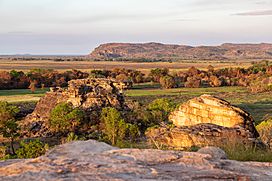Arnhem Land tropical savanna facts for kids
Quick facts for kids Arnhem Land tropical savanna |
|
|---|---|

Nadap Lookout in Kakadu National Park
|
|

Map of the Arnhem Land tropical savanna ecoregion
|
|
| Ecology | |
| Realm | Australasian |
| Biome | tropical and subtropical grasslands, savannas, and shrublands |
| Borders | Carpentaria tropical savanna and Kimberley tropical savanna |
| Geography | |
| Area | 154,737 km2 (59,744 sq mi) |
| Country | Australia |
| States | Northern Territory |
| Conservation | |
| Conservation status | Relatively stable/intact |
| Protected | 55,398 km² (36%) |
The Arnhem Land tropical savanna is a special natural area in Australia's Northern Territory. It's a type of ecoregion with lots of tropical and subtropical grasslands, savannas, and shrublands, which means it has open woodlands and grassy areas.
Contents
Where in the World Is It?
This amazing ecoregion covers the Arnhem Land peninsula and some islands nearby. These islands include the Tiwi Islands, Groote Eylandt, and the Wessel Islands.
The western part of Arnhem Land has tough sandstone plateaus and deep gorges. Other parts of the peninsula are flatter. Here you'll find wide river floodplains and low coastal areas.
Arnhem Land is surrounded by different seas. To the northwest is the Timor Sea. To the north is the Arafura Sea. And to the east, you'll find the Gulf of Carpentaria. Other similar natural areas, like the Kimberley tropical savanna and the Carpentaria tropical savanna, are next to it.
What's the Weather Like?
The Arnhem Land tropical savanna has a tropical savanna climate. This means the weather changes a lot between seasons.
- Wet Season: From November to March, it's the wet season. This is when most of the rain falls.
- Dry Season: The rest of the year is mostly dry, with very little rain.
How much rain falls can vary. Some southern parts get about 1200 mm of rain each year. But the Tiwi Islands in the northwest can get up to 1800 mm! The average highest temperatures are usually between 27º and 33º C.
Plants of the Savanna
The main type of plant life here is woodland. You'll see lots of Eucalyptus tetrodonta (called Darwin stringybark) and Eucalyptus miniata (Darwin woollybutt) trees. These trees stay green all year and form an open roof, up to 20 meters tall.
Underneath the trees, there's tall grass. Most of this grass is a type called Sorghum, which can grow up to 2.5 meters high!
Rainforest Patches
You can also find small areas of monsoon rainforest. These spots have rich soil and are protected from fires. They also get water from underground or from rivers and streams, even in the dry season. The plants here are different from the eucalyptus woodlands.
These rainforests have evergreen, semi-evergreen, and deciduous trees. Many woody vines climb up into the tree canopy. A special tree found here is Allosyncarpia ternata. Near the coast, you'll find tall forests and thick vine areas. Along rivers, there are evergreen "gallery forests." You can also spot evergreen forest patches at the bottom of cliffs.
Other Plant Areas
- Heathlands: These grow on the sandstone plateaus where the soil is thin and acidic. Many unique plants that are found nowhere else live here.
- Floodplains: These areas have sedges and grasslands.
- Swamp Forests: These are full of Melaleuca trees.
- Mangrove Forests: These grow along the coast in salty water.
Animals of the Savanna
This ecoregion is home to many native animals.
Mammals
Some of the mammals you might see include:
- Agile wallaby (Macropus agilis)
- Common wallaroo (Osphranter robustus)
- Antilopine kangaroo (Ospranter antilopinus)
- Northern quoll (Dasyurus hallucatus)
- Short-beaked echidna (Tachyglossus aculeatus)
- Northern brushtail possum (Trichosurus arnhemensis)
- Common brushtail possum (Trichosurus vulpecula)
- Rock-haunting ringtail possum (Petropseudes dahli)
- Sugar glider (Petaurus breviceps)
- Dusky rat (Rattus colletti)
- Pale field rat (Rattus tunneyi)
Unique Species
Some animals are found only in Arnhem Land. These include:
- The Arnhem shovel-nosed snake (Brachyurophis morrisi)
- The Kakadu dunnart (Sminthopsis bindi)
- The Arnhem Land rock rat (Zyzomys maini)
- The Kakadu pebble-mound mouse (Pseudomys calabyi)
Protected Areas
A large part of the Arnhem Land tropical savanna is protected. About 36% of this ecoregion is in special protected areas. This helps keep the plants and animals safe.
Some of these protected areas are:
- Kakadu National Park
- Djukbinj National Park
- Nitmiluk National Park
- Garig Gunak Barlu National Park
- Mary River National Park
- Litchfield National Park
There are also many Indigenous protected areas here. These are managed by Aboriginal people who have a deep connection to the land. They include:
- Anindilyakwa
- Dhimurru
- Djelk
- Laynhapuy–Stage 1
- Marthakal
- Warddeken
- The northern part of South-East Arnhem Land

